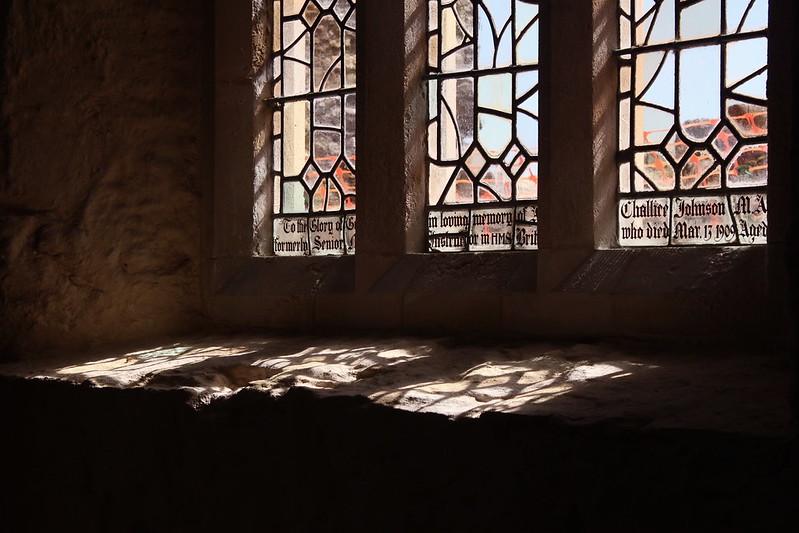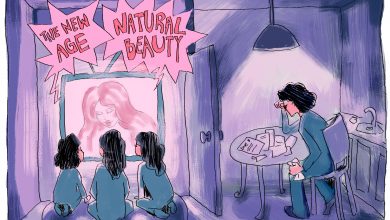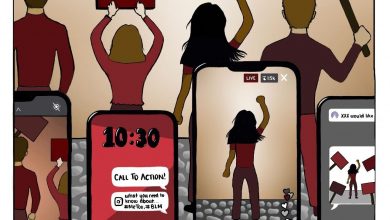Reflecting on Life Inside the Bubble

Photo by Mary Hope Kelly 101 via Flickr
Image description: Sunlight shines through three grisaille windows with a memorial inscription at their bottoms. The light casts geometric shadows onto a stone platform below.
Being educated in a toxic religious environment has taught me a lot about religion. More than anything, it has taught me about the Christian doctrine of my parents. Growing up attending religious institutions from the moment I was first enrolled in school, I have also come to realize the ways that it was used as a mechanism to silence my voice instead of fostering growth. I had not realized the extent to which the negative environment had affected me until having a conversation with one of my best friends from high school, Alicia (A). Although we did not meet until high school, we both had a lifetime of religious education which had created similar experiences for the pair of us. The following conversation is our attempt to dive into what growing up religious in religious education had meant to us, now as women who have been able to distance ourselves from the toxic religious environments of the past and as women more firm in our identities.
A: There is a unique kind of trauma that is a side effect of growing up in religious schooling. Trauma by definition is a deeply distressing experience and as a child, a majority of those experiences go unrecognized. It was not always overt … we were never in physical danger, we weren’t screamed at by religious figures and I think the subtlety of it all is what makes it all that more sick. It’s the small, 5-minute encounters you remember years later, wondering if the other person knew the weight their words carried.
J: Looking back on my religious upbringing, I am finally starting to see how the years of damage a lifetime in Christian schooling impacted my worldview. There was a unique kind of trauma that came from constantly hearing that we must love others and judge not while being blatantly mistreated by students and staff alike in what was supposed to be a Holy institution. Although my experiences felt unique, I quickly realized that what I had gone through was actually quite normal as I scrolled through hours of TikToks discussing the effects of religious trauma on other so-called non-normative students. The further down I scrolled, the more I realized that each person had gone through trauma that could only be harbored in religious education. It seemed as though there was a unique way of being destroyed that was brought on by feeling different from your peers. In my venture to learn more about my own experiences, I found myself learning more about others’ experiences and the extent to which religious trauma can damage a person’s wellbeing.
J: Although religious trauma is not officially recognized in many professional mental health capacities, there are definite ways that the mental health field has taken note of the individual damage done by religion. There are entire history books that can account for the harms inflicted on societies at large. For the purpose of speaking to the experiences of the individual, those will be saved for another day. For clarification, this is in no way my declaration that I hate religion, just my way of looking back on the past and recognizing where things might have been different if my surroundings had been more secular. For example, my natural inclination to want to explore my sexuality turned to nights of nonstop crying begging a God I was not sure existed to take away my curiosity. As I continue to reflect on each instance where religious indoctrination has affected my mental well-being, I have found myself finally being comfortable sharing with those I had bonded with in my lowest times. Particularly, by compiling the stories of myself and a close friend, both of us have been able to recognize the misplaced shame in our pasts.
J: A major issue I noticed throughout my education was the extent to which they included strictly interpreted morality into everything from dress code to courses. However, most of the time the regulations were not enforced the same for all students. In particular, it always surprised me how comfortable the faculty was with over-sexualizing and criticizing the outfits of the young female students. Specifically, many of the traits that were overly sexualized on campus were directly tied to ethnic or racial identity. For example, many women on campus noticed that regardless of how the uniform looked or fit if a girl was not white, they were more likely to be written up for dress code violations. It had become so noticeable that girls would joke about it frequently in the locker rooms yet nobody ever actually spoke up about what was going on.
I had encountered this very issue rather early on and in ways that still disgust me. A few days into my freshman year, I made the mistake of wearing knee-high socks with my school uniform. That one instance solidified my presence on campus for the following years as one teacher stepped in and boldly proclaimed that I was not going to get away with “that type of behavior” with my “prostitute socks.” That teacher proceeded to tell every student in her upper-division math classes that day that a “little freshman who looked like a prostitute” had the audacity to cut one of her favorite students. The following weeks were filled with taunting by male upperclassmen and knee-high socks were immediately banned following the incident, with the explanation that they promote “ungodly forms of work.” It seemed like nobody cared about the constant cat-calling by older male students because it all served its purpose in their eyes of making sure that I never wore the socks again.
From that point on, my uniform choices became a point in many other instances as teachers would follow me around campus checking my skirt near constantly, and even once lifting my shirt without my consent in front of the boys’ basketball team to check that my skirt was on properly. It was, and the boys proceeded to mock me while the teacher turned a blind eye to my obvious discomfort. I had been called a “streetwalker” on several occasions despite being underage and following the outlined dress code regulations of the school.
J: To be clear, I was never upset that they called me names that were synonymous with sex work, but it did upset me that they used the terms in a context that suggested a lack of morality and hyper-sexuality on a child whom they were supposed to be educating. When I had finally stood up for myself in the final semester of high school, I was sent to a school counselor and told that my morality was questionable, and I needed to re-evaluate my core values because everyone had been merely responding to my ‘overtly sexual presentation.’ Contrarily, students that were considered the ‘perfect Christian girls’ would regularly violate dress code regulations and were told nothing. I had come to realize that at school, I was hypervisible. Not only as a woman of color in a predominantly white institution but also as a person who had clearly not shared their worldview. When combined, I became the antithesis of the ‘perfect Christian girl’ and as a result, it became easy to pick on the easy things, like my uniform, instead of those things they could not blatantly criticize (like my religious affiliation or lack thereof). Although only a small cluster of experiences, the reactions of students and staff alike were representative of the much deeper issues with the institution at large as students were blamed for the shortcomings of staff and were instilled with deep guilt in the name of religion.
A: The single most eye-opening experience for me while in Christian schooling was a mission trip I took to Zuni, New Mexico. We did prepare for a couple months prior to the trip but most of this preparation was either lesson planning or organization . In areas such as learning about the culture or history of the Zuni people, we were grossly uninformed. The adults that went with us told us to prepare ourselves because what we were going to be exposed to might be very difficult to process as it was a challenge to our belief. Some of the topics we discussed about the Zuni people before going were the issues of alcoholism in the community, extreme poverty and the statistics of many children having one or more dead parents. In retrospect, it’s shameful that the history of this was never explored. We never had any discussion as to how these issues took root or the sociological aspects of the community we spent such intimate time with.
I had an interaction with a young girl that was part of the Zuni people and it really impacted me because it was something I expected but was still unsure of how to handle. I was assisting some kids in the second grade with the school we were working with and this little girl took a liking to me. I bent down to help her and she told me I smelled like her mom and she said she missed her mom. I naively asked her where her mom was and she quietly told me her mother was dead. This is exactly the kind of interaction we needed to be prepared for because up until that moment I had never had a child tell me anything like that. I did not know what to say or how to comfort her because I don’t think preaching to her would have done much to lift her spirits. We were armed with Bible verses but not real-world tools to deal with these harsh realities.
The first night we stayed in Zuni, we watched a traditional dance the Zuni people did. The ceremony itself had little impact on me; it was the response my peers had that really left an impact. As soon as we got back to the school we were staying at, a lot of my peers started crying and I didn’t quite understand why at first. As people began to express their thoughts, the reason behind this was they felt the Zuni people were lost or misguided and this induced a very emotional reaction. At first, I almost had this sense of guilt, like I wasn’t as connected to God as they were because I wasn’t crying. It was a really strange experience because even though I had this guilt that I didn’t quite understand, I still had no desire to do anything about it. I think I just accepted that I didn’t process things the same way as my peers because I didn’t feel that pressure to go talk to small children all day about Jesus. This experience, along with evangelizing to community members who appeared to have no interest in what we had to offer, were some prominent examples of a white, Christian superiority permeating a mission trip.
In no way am I implying I have the authority to speak on behalf of the Zuni people, but I do think there should be a lot more effort put into educating students about indigenous cultures. Mission trips have become a very touchy topic for me because I like the idea of bringing marginalized people into the spotlight, but I think using religious outreach as the basis for this is a very dangerous game. After more exposure to different groups of people in college, it didn’t sit well with me that tools of colonization, such as mission trips, are still so active today. This particular type of evangelizing is extremely invasive to indigenous people and feeds into a white savior complex.
J: Although a series of arguably minor encounters, each was more memorable than the last. Life has since then been an ongoing attempt to undo the years of indoctrination that dictated life through dichotomous lenses of right and wrong. There are decades of experience to build on, but between the two of us, the mentioned experiences serve as both the most memorable and the easiest to talk about. Since both of us still live with our very conservative parents and have yet to fully break away from our religious backgrounds, it still feels like there are years of reflection ahead. Recounting on the past has brought up conversations about those who remain in the bubble of our religious school, continuing on a legacy of extreme conservative values and white saviorism. It feels strange realizing how far we have come and how different life is from inside the bubble and now living life outside of it. It is also entirely rewarding to now recognize that we were never alone.




